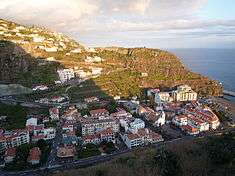Ribeira Brava, Madeira
| Ribeira Brava | |||
| Municipality (Concelho) | |||
 Main centre of Ribeira Brava along the valley of the same name, and at the coast | |||
|
|||
| Official name: Concelho da Ribeira Brava | |||
| Name origin: Portuguese for angry river | |||
| Country | |||
|---|---|---|---|
| Autonomous Region | |||
| Island | Madeira | ||
| Civil Parishes | Campanário, Ribeira Brava, Serra de Água, Tabua | ||
| Landmark | Church of São Bento | ||
| Center | Ribeira Brava | ||
| - coordinates | 32°41′N 17°3′W / 32.683°N 17.050°WCoordinates: 32°41′N 17°3′W / 32.683°N 17.050°W | ||
| Lowest point | |||
| - elevation | 0 m (0 ft) | ||
| Area | 65.41 km2 (25 sq mi) | ||
| Population | 13,375 (2011) | ||
| Density | 204/km2 (528/sq mi) | ||
| Settlement | c.1500 | ||
| - Municipality | 6 May 1914 | ||
| LAU | Câmara Municipal | ||
| - location | Rua do Visconde, 56 | ||
| President | Ricardo Nascimento (PSD) | ||
| Municipal Chair | João Luís Drumond Henriques (PSD) | ||
| Timezone | WET (UTC0) | ||
| - summer (DST) | WEST (UTC+1) | ||
| Postal Zone | 9350 | ||
| Area Code & Prefix | (+351) 291 XXX-XXXX | ||
| Demonym | Ribeira-bravense | ||
| Patron Saint | São Bento | ||
| Municipal Holidays | 29 June | ||
 Administrative location of the municipality of Ribeira Brava in the archipelago of Madeira | |||
| Wikimedia Commons: Ribeira Brava | |||
| Website: http://www.cm-ribeirabrava.pt | |||
Ribeira Brava (Portuguese pronunciation: [ʁiˈβɐjɾɐ ˈβɾavɐ]) is a municipality on the island of Madeira, in the Portuguese Autonomous Region of Madeira. It is located along the southern coast (approximately centre), and is west of Câmara de Lobos and the regional capital Funchal, south of São Vicente, and east of Ponta do Sol. The population in 2011 was 13,375,[1] in an area of 65.41 km².[2]
The municipality gained its name due to its river - Ribeira Brava, which translates as 'the angry river'. In rainy seasons, the river had an extremely strong and powerful current, that often wreaked havoc over the entire eight kilometres of the route.
Geography
_following_heavy_rain%2C_Ribeira_Brava%2C_Maderia%2C_Portugal.jpg)
The municipality's namesake, the Ribeira Brava ravine and river valley extends from the slopes of the west-central mountains of Madeira. Its waters provide the primary sources of drinking-water (a small reservoir collects surface run-off) to the area and electricity to the island of Madeira. Approximately ten tributaries feed this river, whose course ends in the Serra de Água and which much later empties into the Atlantic along the village's coast.
The primary urban agglomerations are the four civil parishes, constituted with their own local government. They include:
Buildings and structures
The Centro Desportivo da Madeira stadium is located in the municipality.
References
- ↑ Instituto Nacional de Estatística
- ↑ Eurostat Archived September 6, 2014, at the Wayback Machine.

